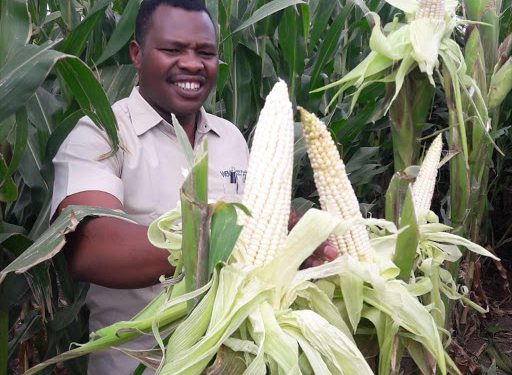•Dr Eliud Kireger of the Kenya Agricultural and Livestock Research Organisation and Prof Theoplius Mutui from the Kenya Plant Health Inspectorate Services provide valuable insights into these distinctions.
•They shed light on how genetic modifications and hybrid breeding techniques impact crop performance, yield, and farming practices.
Understanding how GMOs differ in traits, development, and farming benefits is important for farmers and consumers.
Dr Eliud Kireger of the Kenya Agricultural and Livestock Research Organisation and Prof Theoplius Mutui from the Kenya Plant Health Inspectorate Services provide valuable insights into these distinctions.
They shed light on how genetic modifications and hybrid breeding techniques impact crop performance, yield, and farming practices.
The scientists note that while both types of crops aim to enhance agricultural productivity and resilience, they differ significantly in their development and characteristics.
Kireger said genetically modified organisms, are crops that have undergone genetic alterations such as deletions, inversions, insertions, or translocations of genes to confer specific traits.
These traits can include drought tolerance, high yield, longer shelf life, disease resistance, and pest resistance—attributes often difficult to find in nature. On the other hand, hybrids have been around for over 50 years.
“A hybrid is an improved breed. We have hybrid maize, and we have hybrid beans,” he says.
He said crosses of different breeds, like the Holstein Fresians, are also considered hybrids.
He cites the famous maize variety 614 as an example of a hybrid currently grown by farmers.
Another well-known hybrid maize is the Katumani variety, popular in Eastern Kenya.
Hybrids are created by crossing different breeds with various attributes, such as fast growth or pest tolerance, to produce a plant with improved characteristics. All maize varieties such as 614, 511, and Nyota beans are hybrids, not GMOs.
Hybrids in crops result from crossing high-quality parent plants selected for specific traits, such as high yield, early maturity, drought tolerance, disease resistance, taste, colour, and nutritional value.
These hybrids benefit from hybrid vigour, which has a better combination of traits resulting from the cross.
Kireger also discusses conventional seeds, also known as traditional varieties.
The primary difference between traditional varieties and hybrids is that hybrids have been specifically improved for pest resistance, disease resistance, or higher yields.
He notes that developing new hybrid varieties is an ongoing process influenced by farmers’ needs and external factors such as climate change, pests, and diseases.
“Breeders breed for what is demanded. If you want maize for roasting with a nice aroma or taste, you select for that. If you want maize that doesn’t lodge or collect water, you select for that too. You breed for what the market requires, and the requirements change over time,” he says.
Prof. Theoplius Mutui, Managing Director of Kenya Plant Health Inspectorate Services (KEPHIS), adds that hybrids are produced by crossing one parent with another to create an offspring that combines the desirable characteristics of both parents.
The advantages of hybrids include generally higher yields compared to open-pollinated varieties and uniformity in colour, maturity, and other traits, which facilitates mechanization for tasks like fertilizer application, spraying, and harvesting.
This uniformity, Mutui says, also gives hybrids market advantages due to their adherence to quality standards.
However, hybrids come with disadvantages. The seeds are more expensive, and new seeds must be purchased every planting season.
Additionally, hybrids require more inputs, including fertilisers and pest control, to achieve high yields.
“If you plant hybrids and don’t use fertiliser or spray, you get lower yields. The seeds are costly, and higher agronomic practices are needed. Moreover, hybrids are susceptible to stress conditions like drought and high temperatures,” he says.
•Dr Eliud Kireger of the Kenya Agricultural and Livestock Research Organisation and Prof Theoplius Mutui from the Kenya Plant Health Inspectorate Services provide valuable insights into these distinctions.
•They shed light on how genetic modifications and hybrid breeding techniques impact crop performance, yield, and farming practices.
Understanding how GMOs differ in traits, development, and farming benefits is important for farmers and consumers.
Dr Eliud Kireger of the Kenya Agricultural and Livestock Research Organisation and Prof Theoplius Mutui from the Kenya Plant Health Inspectorate Services provide valuable insights into these distinctions.
They shed light on how genetic modifications and hybrid breeding techniques impact crop performance, yield, and farming practices.
The scientists note that while both types of crops aim to enhance agricultural productivity and resilience, they differ significantly in their development and characteristics.
Kireger said genetically modified organisms, are crops that have undergone genetic alterations such as deletions, inversions, insertions, or translocations of genes to confer specific traits.
These traits can include drought tolerance, high yield, longer shelf life, disease resistance, and pest resistance—attributes often difficult to find in nature. On the other hand, hybrids have been around for over 50 years.
“A hybrid is an improved breed. We have hybrid maize, and we have hybrid beans,” he says.
He said crosses of different breeds, like the Holstein Fresians, are also considered hybrids.
He cites the famous maize variety 614 as an example of a hybrid currently grown by farmers.
Another well-known hybrid maize is the Katumani variety, popular in Eastern Kenya.
Hybrids are created by crossing different breeds with various attributes, such as fast growth or pest tolerance, to produce a plant with improved characteristics. All maize varieties such as 614, 511, and Nyota beans are hybrids, not GMOs.
Hybrids in crops result from crossing high-quality parent plants selected for specific traits, such as high yield, early maturity, drought tolerance, disease resistance, taste, colour, and nutritional value.
These hybrids benefit from hybrid vigour, which has a better combination of traits resulting from the cross.
Kireger also discusses conventional seeds, also known as traditional varieties.
The primary difference between traditional varieties and hybrids is that hybrids have been specifically improved for pest resistance, disease resistance, or higher yields.
He notes that developing new hybrid varieties is an ongoing process influenced by farmers’ needs and external factors such as climate change, pests, and diseases.
“Breeders breed for what is demanded. If you want maize for roasting with a nice aroma or taste, you select for that. If you want maize that doesn’t lodge or collect water, you select for that too. You breed for what the market requires, and the requirements change over time,” he says.
Prof. Theoplius Mutui, Managing Director of Kenya Plant Health Inspectorate Services (KEPHIS), adds that hybrids are produced by crossing one parent with another to create an offspring that combines the desirable characteristics of both parents.
The advantages of hybrids include generally higher yields compared to open-pollinated varieties and uniformity in colour, maturity, and other traits, which facilitates mechanization for tasks like fertilizer application, spraying, and harvesting.
This uniformity, Mutui says, also gives hybrids market advantages due to their adherence to quality standards.
However, hybrids come with disadvantages. The seeds are more expensive, and new seeds must be purchased every planting season.
Additionally, hybrids require more inputs, including fertilisers and pest control, to achieve high yields.
“If you plant hybrids and don’t use fertiliser or spray, you get lower yields. The seeds are costly, and higher agronomic practices are needed. Moreover, hybrids are susceptible to stress conditions like drought and high temperatures,” he says.
•Dr Eliud Kireger of the Kenya Agricultural and Livestock Research Organisation and Prof Theoplius Mutui from the Kenya Plant Health Inspectorate Services provide valuable insights into these distinctions.
•They shed light on how genetic modifications and hybrid breeding techniques impact crop performance, yield, and farming practices.
Understanding how GMOs differ in traits, development, and farming benefits is important for farmers and consumers.
Dr Eliud Kireger of the Kenya Agricultural and Livestock Research Organisation and Prof Theoplius Mutui from the Kenya Plant Health Inspectorate Services provide valuable insights into these distinctions.
They shed light on how genetic modifications and hybrid breeding techniques impact crop performance, yield, and farming practices.
The scientists note that while both types of crops aim to enhance agricultural productivity and resilience, they differ significantly in their development and characteristics.
Kireger said genetically modified organisms, are crops that have undergone genetic alterations such as deletions, inversions, insertions, or translocations of genes to confer specific traits.
These traits can include drought tolerance, high yield, longer shelf life, disease resistance, and pest resistance—attributes often difficult to find in nature. On the other hand, hybrids have been around for over 50 years.
“A hybrid is an improved breed. We have hybrid maize, and we have hybrid beans,” he says.
He said crosses of different breeds, like the Holstein Fresians, are also considered hybrids.
He cites the famous maize variety 614 as an example of a hybrid currently grown by farmers.
Another well-known hybrid maize is the Katumani variety, popular in Eastern Kenya.
Hybrids are created by crossing different breeds with various attributes, such as fast growth or pest tolerance, to produce a plant with improved characteristics. All maize varieties such as 614, 511, and Nyota beans are hybrids, not GMOs.
Hybrids in crops result from crossing high-quality parent plants selected for specific traits, such as high yield, early maturity, drought tolerance, disease resistance, taste, colour, and nutritional value.
These hybrids benefit from hybrid vigour, which has a better combination of traits resulting from the cross.
Kireger also discusses conventional seeds, also known as traditional varieties.
The primary difference between traditional varieties and hybrids is that hybrids have been specifically improved for pest resistance, disease resistance, or higher yields.
He notes that developing new hybrid varieties is an ongoing process influenced by farmers’ needs and external factors such as climate change, pests, and diseases.
“Breeders breed for what is demanded. If you want maize for roasting with a nice aroma or taste, you select for that. If you want maize that doesn’t lodge or collect water, you select for that too. You breed for what the market requires, and the requirements change over time,” he says.
Prof. Theoplius Mutui, Managing Director of Kenya Plant Health Inspectorate Services (KEPHIS), adds that hybrids are produced by crossing one parent with another to create an offspring that combines the desirable characteristics of both parents.
The advantages of hybrids include generally higher yields compared to open-pollinated varieties and uniformity in colour, maturity, and other traits, which facilitates mechanization for tasks like fertilizer application, spraying, and harvesting.
This uniformity, Mutui says, also gives hybrids market advantages due to their adherence to quality standards.
However, hybrids come with disadvantages. The seeds are more expensive, and new seeds must be purchased every planting season.
Additionally, hybrids require more inputs, including fertilisers and pest control, to achieve high yields.
“If you plant hybrids and don’t use fertiliser or spray, you get lower yields. The seeds are costly, and higher agronomic practices are needed. Moreover, hybrids are susceptible to stress conditions like drought and high temperatures,” he says.
•Dr Eliud Kireger of the Kenya Agricultural and Livestock Research Organisation and Prof Theoplius Mutui from the Kenya Plant Health Inspectorate Services provide valuable insights into these distinctions.
•They shed light on how genetic modifications and hybrid breeding techniques impact crop performance, yield, and farming practices.
Understanding how GMOs differ in traits, development, and farming benefits is important for farmers and consumers.
Dr Eliud Kireger of the Kenya Agricultural and Livestock Research Organisation and Prof Theoplius Mutui from the Kenya Plant Health Inspectorate Services provide valuable insights into these distinctions.
They shed light on how genetic modifications and hybrid breeding techniques impact crop performance, yield, and farming practices.
The scientists note that while both types of crops aim to enhance agricultural productivity and resilience, they differ significantly in their development and characteristics.
Kireger said genetically modified organisms, are crops that have undergone genetic alterations such as deletions, inversions, insertions, or translocations of genes to confer specific traits.
These traits can include drought tolerance, high yield, longer shelf life, disease resistance, and pest resistance—attributes often difficult to find in nature. On the other hand, hybrids have been around for over 50 years.
“A hybrid is an improved breed. We have hybrid maize, and we have hybrid beans,” he says.
He said crosses of different breeds, like the Holstein Fresians, are also considered hybrids.
He cites the famous maize variety 614 as an example of a hybrid currently grown by farmers.
Another well-known hybrid maize is the Katumani variety, popular in Eastern Kenya.
Hybrids are created by crossing different breeds with various attributes, such as fast growth or pest tolerance, to produce a plant with improved characteristics. All maize varieties such as 614, 511, and Nyota beans are hybrids, not GMOs.
Hybrids in crops result from crossing high-quality parent plants selected for specific traits, such as high yield, early maturity, drought tolerance, disease resistance, taste, colour, and nutritional value.
These hybrids benefit from hybrid vigour, which has a better combination of traits resulting from the cross.
Kireger also discusses conventional seeds, also known as traditional varieties.
The primary difference between traditional varieties and hybrids is that hybrids have been specifically improved for pest resistance, disease resistance, or higher yields.
He notes that developing new hybrid varieties is an ongoing process influenced by farmers’ needs and external factors such as climate change, pests, and diseases.
“Breeders breed for what is demanded. If you want maize for roasting with a nice aroma or taste, you select for that. If you want maize that doesn’t lodge or collect water, you select for that too. You breed for what the market requires, and the requirements change over time,” he says.
Prof. Theoplius Mutui, Managing Director of Kenya Plant Health Inspectorate Services (KEPHIS), adds that hybrids are produced by crossing one parent with another to create an offspring that combines the desirable characteristics of both parents.
The advantages of hybrids include generally higher yields compared to open-pollinated varieties and uniformity in colour, maturity, and other traits, which facilitates mechanization for tasks like fertilizer application, spraying, and harvesting.
This uniformity, Mutui says, also gives hybrids market advantages due to their adherence to quality standards.
However, hybrids come with disadvantages. The seeds are more expensive, and new seeds must be purchased every planting season.
Additionally, hybrids require more inputs, including fertilisers and pest control, to achieve high yields.
“If you plant hybrids and don’t use fertiliser or spray, you get lower yields. The seeds are costly, and higher agronomic practices are needed. Moreover, hybrids are susceptible to stress conditions like drought and high temperatures,” he says.




















